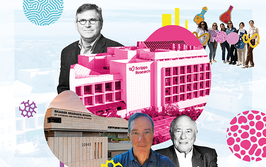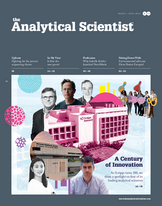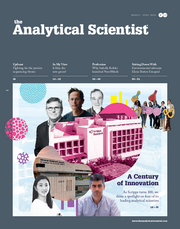Have We Really Peaked?
Liquid chromatography is not just an analytical tool for today, it offers a great deal for the future.
Compared with 20 or 30 years ago, today’s routine LC separations are much faster and have higher resolution. Columns are far better deactivated and much more base-tolerant and reliable. The biggest single benefit from these developments has been the increased productivity of the individual analyst.
I won’t mention names of individuals or vendors: it’s not who you name, it’s who you overlook and wish you had named. In reality, countless thousands of scientists, engineers and computer scientists have made important contributions to the development of LC. Identifiable important trends include the steady progress in developing and using smaller particles, the use of higher pressures, and development of instruments with decreased extra-column dispersion. Equally important are the improvements in silica support synthesis, more inert and hydrolytically stable bonded phases, and novel particle morphologies such as core-shell particles.
One of the sharpest tools in the box
The impact of LC is well recognized and it is regarded as an essential tool in the analytical toolbox. However, let’s not forget that a lot of room for improvement and development remains. For example, there is a real need – driven by proteomics as well as by protein-based pharmaceuticals – for better columns for separating intact proteins. Metabolomics is also driving the necessity for more capable stationary phases for retaining highly-polar metabolites, while using mass spectrometry (MS) compatible mobile phases. And, for the foreseeable future, nanomaterials and nanoparticles are poised to be important. Surely, LC offers much for the analysis and purification of nanoparticles; however, this may require improvements in modes such as hydrodynamic chromatography, size exclusion chromatography, or LC-related technologies, such as field-flow fractionation.
As we push the limits of LC, I would love to see more studies involving molecular dynamics simulations of analytes and their interactions with stationary and mobile phases. As people become more adept at molecular dynamics simulations, I think there is much we can learn about retention kinetics and equilibria. Smaller particles have been a steady trend in LC; and, I see no reason for that trend to stop. Also, the use of high temperatures in LC is interesting, but always must be taken on a case-by-case basis. The biggest concern is the thermal stability of the analytes. In addition, can we continue to aim for higher pressures? Why not? High pressure (unlike high temperature) tends to be benign in terms of analyte stability.
One thing is clear: we have a pressing need for new types of LC stationary phases. Classic reversed phase is wonderful, and will continue to be the workhorse method in the future, but it won’t work for everything. There are a lot of questions that need answering, such as how do we best handle highly polar small molecules (for example, metabolites)? Are there possibilities for novel alternative mobile phases or mobile phase additives? Are there practical alternatives to water for higher-polarity mobile phases?
Risky business?
How can we as a community organize a dedicated effort to further advancing LC? Well, I can’t think of anyone who would refuse more funding or collaboration for separations research. But in reality, collaborations tend to be best initiated from the bottom up by individual researchers. Furthermore, it is just as important for researchers in separations to interact with people in biochemistry, biology, materials science, engineering, synthetic chemistry, spectroscopy, and mass spectroscopy, as it is for them to interact with other people in separations. The most important thing is for grant awarding bodies to fund good people to do good research – and they shouldn’t be afraid to fund risky research. Risky research usually fails, but it is also the source of unique new approaches...
As to limiting factors, in my opinion, we can never have enough resolution or peak capacity. We should never be satisfied with the status quo. There is no end to our imagination – and that opens up our horizons to other techniques; and how we work with them or embrace them. For example, the role of MS in analysis is constantly increasing. Any development within LC must maintain compatibility with MS. Top-down proteomics of intact proteins is increasingly viable as mass spectrometers become more powerful. We need highly effective columns for separating intact proteins coupled to these new mass spectrometers. There is a long way to go before the chromatography of intact proteins measures up to the great strides taken in the MS of intact proteins.
The future is full of promise, but...
When I look at what’s changed over the past year, I am always disappointed. However, when I look at what has changed over a decade, I am always amazed. How does the incremental accumulation of 10 years’ of disappointments eventually become an exciting qualitative shift in performance? I’m sure one factor is the occasional unanticipated paradigm-shifting development; the electrospray ionization source for MS, for example.
The introduction of monolithic columns as an intelligent stationary phase morphology is permitting greater freedom in design of column architecture. One of the questions that springs to mind about such developments is: can the dimensions of the physical features of successful and efficient monolithic columns be scaled down further to yield still greater efficiencies? The main benefit so far of higher pressures and smaller particles has been greatly increased speed of analysis, with modest improvements in resolution and peak capacity. A second question then: can the benefits of high pressure be extended to longer columns with extraordinary resolving power?
It is difficult to predict what the next big new ideas will be, but a couple of things that cross my mind: will chromatography with slip-flow revolutionize separations, and will advanced 3D printing technologies permit direct fabrication of near-perfect chromatography columns? In reality, I don’t know what the great developments of the next 10 years will be, but I am certain they will happen – and will be remarkable.
Expanding LC Boundaries
By Mary J. Wirth
Marching Ever Onward
By Gert Desmet
Marking Progress
By Monika Dittman and Fabrice Gritti
Jim Jorgenson is William Rand Kenan, Jr Distinguished Professor of Chemistry, University of North Carolina, Chapel Hill, USA.

















